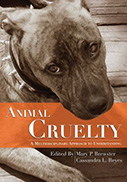Animal Cruelty: A Multidisciplinary Approach to Understanding

Editors: Mary P. Brewster and Cassandra L. Reyes
Publisher: Durham, NC: Carolina Academic Press, 2013. 436p.
Reviewer: Leslie Irvine | May 2014
Although I do not judge books by their covers, I do appreciate good cover design. When I opened the package containing my review copy of Animal Cruelty: A Multidisciplinary Approach to Understanding, I looked at the cover and thought, “Perfect.” A sepia-toned image of a pit bull-type dog in a studded collar fills the entire space. Photographed close up, with head downcast and eyes engaging the viewer, the image of the dog captures many facets of animal cruelty because the pit bull provides a metaphorical linkage to dog fighting — an insidious form of cruelty engaged in for profit. Dog fighting, with its links to gangs, organized crime, gambling, and the drug trade, its brutal training tactics, and its betrayal of the human-canine bond, epitomizes the successes and failures of criminal justice. Historically ignored by law enforcement, and then treated as a petty crime if at all, it now constitutes a federal felony in the United States. It is illegal in the United Kingdom, Canada, Australia, and many other countries. Yet dogfights occur every day, and its practitioners evade law enforcement through secret national and even international networks.
Long considered an issue mainly of concern to animal welfare advocates, scholars from many disciplines now recognize cruelty to animals as a serious social problem on its own, and an augur of other forms of interpersonal violence. The need to understand and prevent animal cruelty as well as legislate against it makes it relevant for researchers, policy makers, and law enforcement professionals. This collection, edited by Mary Brewster and Cassandra Reyes, brings together the best current scholarship on a comprehensive list of topics related to animal cruelty. I know of no other volume that encompasses so many aspects of the phenomenon and includes so many perspectives. Animal Cruelty would provide a useful resource for established scholars in criminology and criminal justice as well as those new to the fields, including students at both the graduate and advanced undergraduate level.
The diversity of disciplines represents one of the volume’s unique strengths. Contributors include many of those who were among the first to recognize animal cruelty as a problem worthy of scholarly attention. The represented disciplines include those usually associated with the study of violent crime, such as criminology, criminal justice, law, and social work. Additional contributions come from fields having less obvious associations, bringing valuable insights to the multifaceted problem of animal cruelty. For example, in a chapter entitled “Animal Cruelty and Reality Television,” media scholar Claire Molloy examines the function of animal suffering within the popular genre of “animal cop” television programs. In the United States, these programs appear on Animal Planet under titles such as Animal Cops: Houston, Animal Cops: Philadelphia, and Miami Animal Police. Molloy situates the programs in the cultural and institutional context of television programming in general, and in reality television, more specifically. These magazine-format shows represent a hybrid of police and medical dramas combined with investigative journalism. Molloy locates the content of animal cop programs somewhere between fetishistic entertainment and evidential depictions of cruelty, the two familiar uses of animal cruelty in media. In the former case, video images depict animal cruelty for sexual pleasure, as in “crush” films. In the latter, campaigns launched by animal advocacy groups often depict cruelty to raise awareness and public support. Molloy situates the “animal cops” programming, which depicts cruelty for mainstream entertainment, between the two extremes. Her analysis of the programs’ structure reveals a narrative arc common to “before and after” stories such as makeover shows. In animal cop shows, the central characters of an innocent, suffering animal, a virtuous, compassionate officer, a cruel or uncaring owner whose guilt is self-evident, and a new owner who provides a loving home help reinforce simplistic moral binaries of good and evil, victim and abuser. Molloy convincingly argues that the shows raise questions about the ethics of using the suffering of animals as not only entertainment, but as a way of enforcing unambiguous ideological boundaries. Whereas scholars have investigated the influence of media on violence directed at human beings, the role of media in cruelty to animals has received little attention. Molloy’s analysis of how reality animal programs contribute to the debate over animal cruelty adds a new dimension to this complex social issue.
The range and timeliness of topics constitutes another strong point of the collection. The contributions examine topics that one might expect to find in a book of this sort, such as the history of animal cruelty laws and summaries of types of cruelty and their prevalence, but they also include discussions of current, controversial, and emerging issues. For instance, in the chapter on “Animal Cruelty and Delinquency, Criminality, and Youth Violence,” Nik Taylor and Tania Signal remind readers that although the “Link,” the term for the relationship between animal abuse and other forms of violent behavior, has long been recognized, ongoing research continues to clarify and refine the nexus of factors involved. Taylor and Signal discuss the disagreement between studies assuming a “graduation thesis” and those that assume the “generalization of deviance” or “desensitization” hypothesis. The graduation thesis maintains that people who abuse animals will “graduate” to human-directed violence. The desensitization or generalization thesis proposes that cruelty to animals represents one manifestation of a general tendency toward antisocial behavior. Although research has failed to find clear support for the graduation thesis, deliberate cruelty to animals committed by children still constitutes a serious behavioral problem, even if it does not lead to human-directed violence. Taylor and Signal summarize the recent research on topics such as the motivations behind acts of cruelty, the role of family and community factors, the gendered differences in perpetration, and the impact of witnessing animal abuse, to name just a few. They also highlight new research suggesting a relationship between condoned animal harm and criminal behavior. This body of work maintains that although traditional definitions of animal abuse focus on acts considered socially unacceptable, considerable harm to animals occurs in the context of acceptable practices, such as the raising and slaughter of animals for food. Scholars have examined how slaughterhouse work requires a reduction of empathy that manifests itself in the deliberate abuse of livestock at meat processing plants. Others have found higher incidences of domestic violence and other criminal behavior in populations of slaughterhouse workers. These studies suggest that the large-scale violence witnessed daily by slaughterhouse workers creates a propensity for other forms of crime. Taylor and Signal point out that, although the treatment of livestock falls largely under the purview of animal welfare, the correlations between violent crime and the presence of a meat processing plant within a community make the topic ripe for criminological research.
Another topic that has only recently received scholarly attention is the phenomenon of animal hoarding, also referred to as “collecting.” The practice involves not only keeping large numbers of animals in overcrowded conditions but also often subjecting them to starvation, disease, and improper care. Moreover, the practice often places family members and neighbors at risk because of unsanitary conditions and zoonotic disease transmission. Animal hoarding constitutes a fruitful topic for criminological study. As Arnold Arluke and Gary Patronek explain in the chapter entitled “Animal Hoarding,” such cases often involve state and local law enforcement, public health agencies, building and zoning departments, animal control, and a range of social services from aging to mental health and child welfare. Animals taken from hoarding situations constitute evidence, and thus must be cared for and housed in shelters until cases are settled. The cost of the resources and expertise involved, which include veterinary care and housing of animals, along with the cleaning or demolition of the dwelling, can place significant burdens on communities. Arluke and Patronek point out the difficulty of prosecuting hoarding cases successfully. Cruelty laws often focus on intent to harm, and hoarders are thus legally seen as neglecting animals, rather than abusing them. This diminishes the seriousness of the animals’ suffering, which, in hoarding cases, can surpass the harm inflicted in deliberate abuse cases. Several criminal justice agencies have joined forces to find ways to make prosecution of hoarding cases more effective. This effort could benefit from empirical research on prevention, detection, and intervention.
Along with contributions on less recognized aspects of animal cruelty, the chapters that examine familiar topics bring in important, fresh insights. For example, Phil Arkow and Randall Lockwood’s opening chapter on “Definitions of Animal Cruelty, Abuse, and Neglect” goes well beyond a “just the facts” discussion to address the pitfalls created by vague and archaic language. They point out the obstacles posed by statutes that include language such as “proper” sustenance, “unnecessary” pain, or “needless” mutilation. Moreover, they point out that, because the first anti-cruelty laws in the United States date from the mid-nineteenth century, references to outdated animal practices still exist in many statutes. “Overloading” animals seldom poses a problem today, as it did when horses provided most means of conveyance. Yet, the language persists in many statutes, despite the lack of standards for when a load becomes too great for a horse to bear. In addition, Arkow and Lockwood point out that many laws fail to even define “animal” or exclude some species from the definition, thus leaving the matter up to the courts and making the prosecution of cruelty nearly impossible.
Overall, Animal Cruelty represents an important addition to the literature, both for its exhaustive examination of topics and for its consistent reminder that cruelty to animals constitutes a legitimate topic for criminological study. Animal Cruelty will serve as a valuable resource for years to come, guiding those who seek to understand the causes and consequences of animal abuse.
Leslie Irvine,
University of Colorado at Boulder, irvinel@colorado.edu

